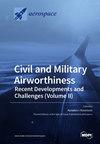小型无人机系统无刷直流电机的传热模型和测量结果
IF 2.1
3区 工程技术
Q2 ENGINEERING, AEROSPACE
引用次数: 0
摘要
传热会影响电机的尺寸、性能,并最终影响整个飞行器的续航能力和耐用性。然而,热学文献中并没有针对小型无人机系统(UAS)中的外转子无刷直流(BLDC)电机的早期模型。为了填补这一空白,我们开发了一种非维度传热模型(努塞尔特相关性)。在雷诺匹配风洞试验中对四种不同尺寸的无刷直流电机进行了负载参数实验,为模型相关性生成了数据。电机的长宽比(直径/长度)从 0.9 到 1.5 不等。电机上方轴向流的自由流雷诺数从 20,000 到 40,000 不等。旋转雷诺数从 10,000 到 20,000 不等。结果表明,长宽比对传热的影响最大,其次是旋转雷诺数和自由流雷诺数。稳态模型利用相关性预测了电机的环境温差,与实验数据相差 10 K。一项案例研究利用相关性预测了假定电机在不同环境下的连续扭矩。该相关性使概念设计人员能够在早期设计阶段捕捉热驱动的权衡,并在后期阶段减少代价高昂的修改。本文章由计算机程序翻译,如有差异,请以英文原文为准。
Heat Transfer Models and Measurements of Brushless DC Motors for Small UASs
Heat transfer affects a motor’s sizing, its performance, and, ultimately, the overall vehicle’s range and endurance. However, the thermal literature does not have early-stage models for outrunner brushless DC (BLDC) motors found in small unmanned aerial systems (UASs). To address this gap, we have developed a non-dimensional heat transfer model (Nusselt correlation). Parametric experiments of four different-sized BLDC motors under load in Reynolds-matched wind tunnel tests generated data for model correlation. The motors’ aspect ratios (diameter/length) ranged from 0.9 to 1.5. The freestream Reynolds number of the axial flow over the motors ranged from 20,000 to 40,000. The rotational Reynolds number ranged from 10,000 to 20,000. The results showed that aspect ratio had the largest influence on heat transfer, followed by rotational and freestream Reynolds numbers. A steady-state model used the correlation to predict the motor’s ambient temperature differential within 10 K of experimental data. A case study applied the correlation to predict a hypothetical motor’s continuous torque in different environments. The correlation enables conceptual designers to capture thermally-driven trade-offs in early design stages and reduce costly revisions in later stages.
求助全文
通过发布文献求助,成功后即可免费获取论文全文。
去求助
来源期刊

Aerospace
ENGINEERING, AEROSPACE-
CiteScore
3.40
自引率
23.10%
发文量
661
审稿时长
6 weeks
期刊介绍:
Aerospace is a multidisciplinary science inviting submissions on, but not limited to, the following subject areas: aerodynamics computational fluid dynamics fluid-structure interaction flight mechanics plasmas research instrumentation test facilities environment material science structural analysis thermophysics and heat transfer thermal-structure interaction aeroacoustics optics electromagnetism and radar propulsion power generation and conversion fuels and propellants combustion multidisciplinary design optimization software engineering data analysis signal and image processing artificial intelligence aerospace vehicles'' operation, control and maintenance risk and reliability human factors human-automation interaction airline operations and management air traffic management airport design meteorology space exploration multi-physics interaction.
 求助内容:
求助内容: 应助结果提醒方式:
应助结果提醒方式:


